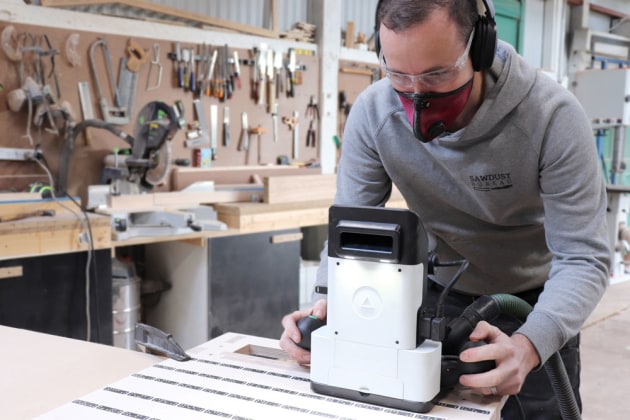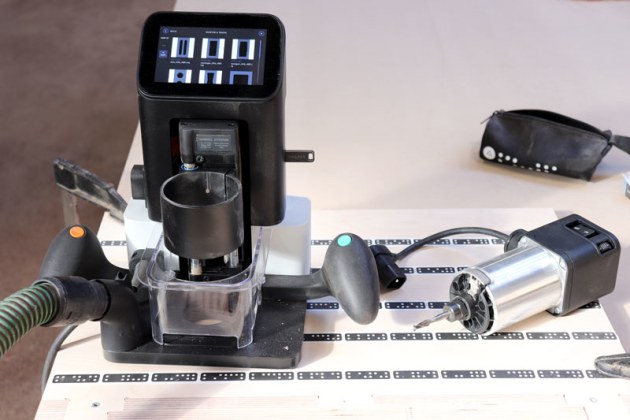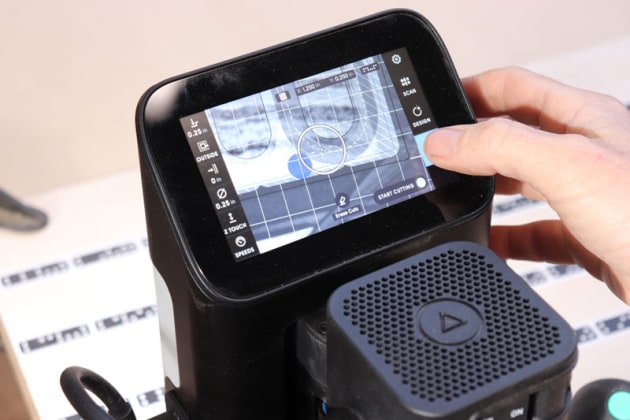Shaper Origin handheld CNC
Words and photos: Bryan Cush
Like many other woodworkers I had been avidly following the development of the Shaper Origin for the past few years; curious to see whether it lived up to the hype.
The first caveat is that the Shaper is currently not available for sale in Australia but I have been running the US version through a step-down voltage transformer with no issues (at time of writing) to report after six weeks usage. The second thing to clear up is that it won’t be replacing traditional CNC any time soon, but perhaps that could be its best attribute – it’s simply not trying to be a standard CNC. On top of the ‘R&D’ price I paid, back then around July 2018, US$290 for shipping and $220 for a transformer. Shaper Origin was only available on a pre-order basis.
The Shaper kit includes 1/8”, 1/4” spiral up-cut bits and a V-profile engraver.
Shaper’s developers describe it as an augmented-reality CNC router. It utilises a forward-facing, high-resolution camera to scan a matrix of their unique ‘domino’ tape stuck down to the workpiece and builds up an augmented XY workspace of an unlimited size.
The Z-axis (up and down) is controlled by a motorised mechanism housed in the spindle mount which can plunge to a maximum of 35mm. The domino tape is a consumable (and not a cheap one at US$18 per roll) however there are plenty of simple tricks to reduce tape usage through templates and jigs, which are shared through an active online Shaper community.
A cut file is placed on the workpiece using the live-view touchscreen.
Once the camera stitches together a composite image there are two options for defining cuts. They can be created in Adobe Illustrator and by matching line types from the provided template file cut, styles such as interior, exterior, on-the-line or pocketing are automatically applied.
These instructions can be overridden at any time on the Shaper without having to revisit a computer; a great time-saving feature. The second option enables the user to create simple shapes and profiles directly on the device with no computer required. This is a key advantage over the often complicated process of preparing CAD files and calculating complex cut paths for a standard CNC.
Shaper utilises a forward-facing, high-res camera to scan a matrix of their unique ‘domino’ tape stuck down to the workpiece.
A cut file is placed on the workpiece using the live-view touchscreen, or if an exact position is required, the router bit can ‘touch off’ along the outer edges of the piece to locate the precise XY position as per the cut file.
The next step is to select the type of router bit being used (included with the Shaper kit are 1/8", 1/4" spiral up-cut bits and a V-profile engraver), the required depth of plunge, and whether an offset to the cut line is required. The offset is a key feature of the tool, allowing roughing passes to remove the majority of the stock, followed by a zero offset, cleanup pass – great for accurately fitting tenons, inlays or dowels where the offset can gradually be stepped down until the perfect fit is found.

Close-up of parts cut ‘freehand’ with Shaper Origin technology.
The operation and interface are highly intuitive and feel more akin to a simple video-game than a power tool, with on-screen prompts such as direction indicators to give you the best finish on interior versus exterior cuts.
Build quality is what you would expect from a product that was developed in partnership with Festool and ergonomics have been well considered, with the raise and lower buttons being conveniently located on the handles. Dust collection is better than most routers I have used with the clear dust shroud doing an excellent job at removing chips and dust.
The relatively small Festool spindle (a 720W trim router) is obviously a trade- off for weight-saving and balance. In my opinion, the decision to opt for high accuracy over high power was definitely the correct one as the Shaper was clearly designed to be used in shallow, offset passes at a slow feed rate to allow the spindle mount enough time to adjust to human error as you try to follow the onscreen cut guidelines.

Test cut mortise and tenons obtained with the Shaper.
The bit can also completely retract if you stray beyond its maximum auto- correct range. Cut quality is much better than I had expected from a ‘freehand’ tool and, so long as shallow passes are used, it is possible to produce extremely accurate lines that require minimal sanding clean-up to remove burrs and burning.
An analogy for Shaper vs CNC machines would be to think of what a track saw is to a tablesaw. It won’t supersede it, but instead offers complementary functionality in a more portable format. The ability to take the tool to the workpiece is a game changer for working on large, heavy pieces of furniture.
If you are imagining the Shaper Origin becoming the daily workhorse of your workshop, powering through 40mm thick solid timber you are likely to be disappointed. However if like me, you see the benefits in combining digital with traditional woodworking practices and using the Shaper as a highly accurate tool for templating (used in conjunction with a more powerful router and pattern bit), engraving and inlaying work then it is a no-brainer purchase for any professional or hobbyist.
Learn more about Shaper Origin at www.shapertools.com
Bryan Cush is a Melbourne based furniture designer and maker. His table The Dish, made for Studio Furniture 2018 is featured in the current issue of the magazine. Learn more about Bryan at www.sawdustbureau.com






